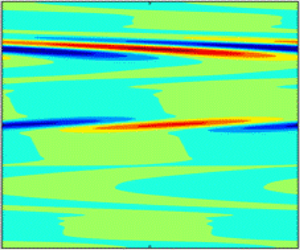Article contents
Effects of phase boundary and shear on diffusive instability
Published online by Cambridge University Press: 22 May 2023
Abstract

We study the diffusive instability subject to a solid–liquid interface and a Kolmogorov flow using modal, non-modal analyses and energy analysis. It is found that the phase boundary has different effects on the threshold of diffusive convection for weak and strong salinity stratification. In the context of oceanography where the salinity Rayleigh number RS is very high, the ice–water interface has negligible influence on the onset of diffusive convection. In the presence of shear, the diffusive convection for RS < 106 tends to be inhibited and with the increase of shear intensity, the oscillatory, steady convective and Kelvin–Helmholtz instabilities will be successively dominant. For RS > 106, the shear has a destabilizing effect on the diffusive convection, due to the generation of thermohaline-sheared instability found by Radko (J. Fluid Mech., vol. 805, 2016, pp. 147–170). Non-modal analysis indicates that for realistic parameters of high-latitude oceans, with the transition of the ultimate energy source of instability from the density gradient to background current, the thermohaline-shear instability is expected to transition from oscillatory to steady instability. The initial transient amplification due to double diffusion has also been studied, which is due to the generation of overstable instability at the initial phase. For RS < 106, the optimal initial condition to achieve the maximum transient growth favours longitudinal rolls. For thermohaline-shear instability, however, it favours transverse rolls and specifically, in oscillatory thermohaline-shear instability, the transient amplification can be enhanced by the shear by one order of magnitude, thus having important influence on the stability of the system.
JFM classification
- Type
- JFM Papers
- Information
- Copyright
- © The Author(s), 2023. Published by Cambridge University Press
Footnotes
The online version of this article has been updated since original publication. A notice detailing the change has also been published.
References
A correction has been issued for this article:
- 3
- Cited by
Linked content
Please note a has been issued for this article.



